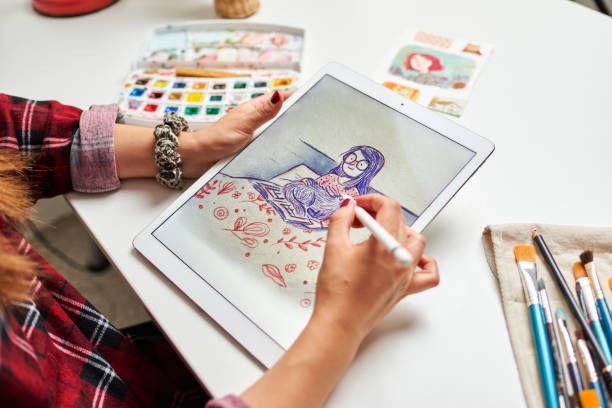You’ve heard the Illustrator job title, but is it just another name for a painter?
Illustrators are artists that work with a customer to make two-dimensional images that summarize an idea, showcase a concept, or compliment a body of text to solve communication problems.
It is a pretty fun job if you prefer diverse creative work. You can work freelance for various companies designing children’s books, product packaging, and other fun stuff. Keep reading to find out!
Job Description
What Is The Illustration?
The illustration is a visual representation of a concept, idea, opinion, or replacement for text whose purpose is typical to draw an emotion from customers and leave a lasting impression.
There are typically four parts of the illustration process, including:
- Meeting the client: First, these experts meet their clients to discuss the design, project requirements, and more. If they work for a company, they may have to meet the project manager to receive their assignment guides.
- Discuss the deadline: After discussing the project’s details, they and their client will make a deadline. It will provide illustrators with a time frame that they can utilize to complete many parts of the project.
- Develop a sample illustration: Illustrators develop sample illustrations to show their clients to ensure clients like the piece and identify any essential changes.
- Complete the illustration: After considering the feedback, these experts complete it by the deadline and deliver their clients with the image.

Who is An Illustrator?
These experts are artists who make two-dimensional images for many industries and companies, such as fashion design, magazines, medical manuals, children’s books, websites, technical designs, advertising, and more.
They use many techniques to make effects, such as the simplicity of black and white, light and shadows, or the richness of color.
The Workplace of an Illustrator
Illustrators often specialize in a specific industry according to their talents and can work as freelancers.
As an illustrator, if you excel in sketching clothing, you can become a fashion illustrator. If foliage, animals, or earth formations are your strength, you might consider becoming a scientific illustrator.
You may consider becoming a medical illustrator, requiring a talent for drawing the schematics of the human body, human organs, surgical procedures, etc.
Illustrators typically work from a studio or out of their homes. They set their working hours depending on deadlines for their workload and the workload they have to fulfill.
They sometimes take the time to meet with customers to discuss assignments. In some cases, they conduct their meetings via phone calls or email.
What Do Illustrators Do?
Here are the tasks that illustrators complete while working:
- Consult over one or more projects: As an illustrator, you will meet clients and project managers to consult on a project’s requirements. You and stakeholders also discuss the type of piece, tone, style, or deadline.
- Use art equipment: These professionals use essential equipment to help them achieve the artistic effects they want. It often consists of paintbrushes, pencils, canvases, and graphic design software.
- Conduct research: These experts research to understand the details of their projects better. They may research the topics and concepts the project relates to, like technical terms or medical concepts.
- Negotiate contracts: Illustrators negotiate contracts that can include details about deadlines, pay, and project agreements.
Job Options for Illustrators
As an illustrator, you can work in different industries, such as graphic design, advertising, publishing, fashion, or the medical or science field.
Medical Illustrators
This field will require biology knowledge, and you need to complete training programs that combine art training and medical studies.
Fashion Illustrators
Fashion Illustrators tend to like graphic designers in the fashion industry.
Fashion illustrators will show their creative ideas for clothes, accessories, and jewelry through sketches.
They also often collaborate with fashion designers to create fashion products.
Publishing Illustrators
Publishing illustrators create art for books, editorial cartoons for online news and newspapers, children’s books, magazines, and other publications.
Advertising Illustrators
These professionals work on packaging, product illustration, storyboard, animation, or other creative illustrations for advertising purposes. Most likely, they’ll be working a lot with digital programs in the field.
Education
Sometimes, formal art training is a requirement to work as an illustrator, while a portfolio may be all that is needed. Nevertheless, relevant bachelor’s and even master’s programs can prove beneficial.
In addition, many take independent classes or complete a workshop to build their knowledge base and hone their skills in the field.
Essential Skills
If you dream of becoming an illustrator, here are the top skills you should have to become one:
- Love For Creating Art.
- Visual Flair.
- Sketching Skills.
- A Unique Style.
- Ability To Convert Concept Into Graphic.
- Good Communication.
- Storytelling.
- Familiarity With IT Software.
- Understanding Visual Language.
Essential Tools
Here are the ten illustrator tools all designers should use:
- The Ruler.
- The Blend Tool.
- The Offset Path.
- The Clipping Mask
- The Artboards Panel.
- The Layers Panel.
- The Pathfinder Panel.
- The Align Panel.
- The Grid.
- Snap to Grid/Pixel Grid.
Job Outlook
It is challenging to say what the future job market for illustrators will look like.
While some artists may still make good money from their jobs, others may become obsolete because of artificial intelligence and machine learning.
The fact is that chances are that computers may produce most of the art in several years while illustrators may no longer be needed for many jobs.
You should not expect a steady cash flow as an illustrator. While some months can be great, others can be pretty bad, and you should also make sure you save enough money in good times to have a financial buffer for bad times that will come sooner or later.
Salary
According to our latest research, the average annual salary for an Illustrator in the US is $63.756, which equates to $30.65 per hour, $1,226 per week, and $5,313 per month.
The majority of illustrators’ salaries range from $41,000 to $80,500 with top earners making $106,000 annually across the United States. Salary can vary depending on many factors, such as skill level, years of experience, and location.
Advantages and Disadvantages
- Ability To Work From Anywhere.
- Chances Of More Income.
- Freedom To Choose Your Work.
- You may be able to become famous.
- Flexible Routine.
- Not be stressed.
- Good work-life balance.
- You can work whenever you want.
- Avoid hard physical work.
- Mostly work indoors.
- You can explore your inner self.
- May be able to travel the world.
- Make our world a better place.
- You can take time off whenever you want.
- Extra Work Time.
- Hard to switch fields.
- Infrequent Work.
- Meet many different tastes.
- Clients can be demanding.
- You may have a difficult time as an illustrator.
FAQs
What Is the Difference Between an Illustrator and a Graphic Designer?

Graphic designers typically work on design elements and structures, delivering a visual brand/message for a company to sell a service or product.
Conversely, illustrators usually do commercial work for firms like publishing houses, advertising agencies, and comic book houses.
Illustrators are responsible for drawing, designing product packaging, creating company logos, and working on book illustrations.
If you like to draw and illustrate concepts, you should consider becoming an illustrator. Yet, the graphic design would be a good fit if you prefer to make websites, code, and undertake detail-type work.
Is Illustrator a Good Career?

It is a promising career if you love creating. Illustrator is considered a competitive career, but there is also a high need for it.
Another good thing about this profession is you can work freelance with ease. So if you love freedom, this is the ideal job for you.
How Can I Learn Illustration?
It is possible to learn illustration online or in design schools.
In most cases, design schools deliver online courses, and there are various online resources. And most importantly, you should practice a lot on your own.
How To Become An Illustrator?
Step 1: Gain a Degree.
Most employers do not require illustrators to hold a bachelor’s degree. So you should consider completing an art program to enhance your knowledge of artistic techniques, styles, and essential skills.
Step 2: Get Experience.
Getting experience in design and art is critical to hone your skills and getting used to various illustration fields and styles.
Consider pursuing an illustration internship, allowing you to observe experienced illustrators and work on some illustration projects.
You can contact the administration at your educational institution to know if there are any internship chances. It will be a good idea to go online to look for art internships that want entry-level illustrators.
Step 3. Define a Specialty.
Once you have achieved enough experience to work as an illustrator, it is time to pursue chances to work in specialty illustration.
Working in various specialties will help you advance your career, as many employers prefer candidates that completed work in many illustration fields.
Consider completing work for clients that involves illustration styles that you are unfamiliar with. If you aren’t familiar with product illustration, consider working on a project that requires conceptualizing and creating products.
Step 4. Make a Portfolio
A portfolio is a great way to show potential employers your artistic style and illustration techniques. Make a portfolio that highlights the work you are most proud of. Including four or five pieces of work in the portfolio will be helpful.
It is best to update a portfolio to ensure it includes your most recent work that fits your clients’ job descriptions and artistic preferences.
For instance, if your customer is looking for an illustrator with experience in book illustration, it is essential to update your portfolio to include some examples of your previous book illustrations.
For detailed instructions, please read this article.
Career Advice
Illustrators often express their ideas through art. It’s a great career if you love creating. In the beginning, they may work as freelancers for many industries.
Then, some illustrators might want to sell their illustrations online, whereas others might prefer working for others. Eventually, they will find out what they are best at.
Illustration can be an excellent and fulfilling career, contributing immensely to society, keeping brands in touch with their customers, simplifying complexes.
If you want to be an illustrator, we wish you good luck and happiness with your career. Thanks for taking the time to follow us!
